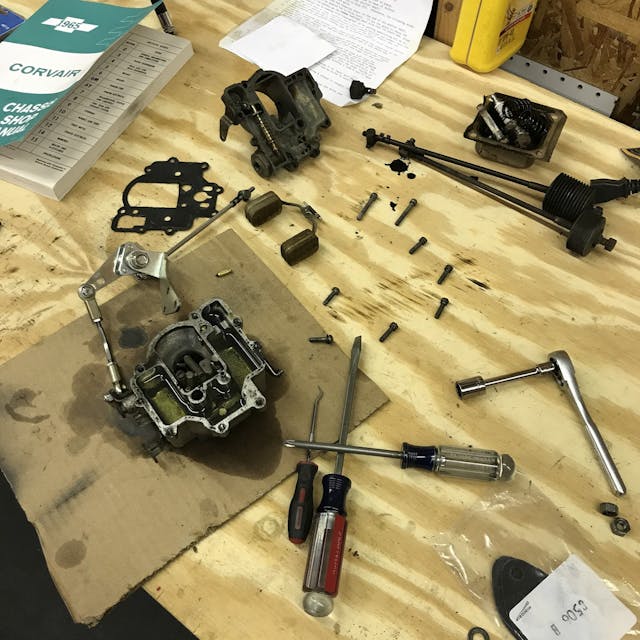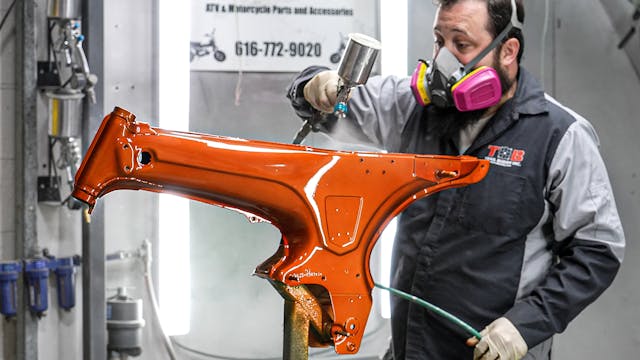The 6 most complicated restoration steps
A restoration in and of itself is complicated. Taking an object that is in less than desirable condition and returning it to its original condition—or as close to it as possible—requires tons of skill and understanding for simple objects. The restoration of a nice hardwood dining table could take weeks to do properly and that is a dozen pieces of wood. Scale that up to an automobile with thousands of precision parts that all have to interact flawlessly and, yeah, restorations are complicated.
Even if you elect to pay a pro there are steps in a restoration that just cause us to grimace at the thought of the task. Could boil down to the cost, time, or complexity of what needs to happen, or it could just be that for reasons unknown you just don’t want to. No matter, here are six of the most complicated restoration steps.
Carburetor rebuilding and tuning

It’s oddly polarizing to say this one, but the fact of the matter is proper care and feeding of carburetors takes an understanding of how they work. Take a minute to talk to a person who doesn’t like carbs and it usually boils down to how finicky the small passages are to keep clean and understanding how one seemingly small change affects the rest of the system. It nearly requires a degree in physics and chemistry to fully grasp just how precision-cut chunks of metal can accurately meter the amount of fuel going into the engine across a range of conditions. In short, it’s complicated.
Cylinder head assembly
The pieces are bigger than carburetors, but assembling a cylinder head requires the same attention to detail and even more specialty tools. Assembling a head that lasts requires setting proper spring pressures and sealing, which involves careful machining, parts selection, and also tidy and careful assembly. Yes, it is possible to just slap one together but could and should are two different things.
Engine machine work
We actually talked about this topic yesterday with a video from Jim’s Machine Shop, Inc on the process to complete just two of the machining steps required to bring a five-decade-old engine block back to service-ready status. It is literally tons of tools that possess the power to save an engine and also could mangle the operator or workpiece in horrific ways if anything but a skilled operator is at the controls. The precision required is humbling and the consequences of getting it wrong are significant.
Differential gear setup
Similar to the cylinder heads, differentials are something that most home mechanics don’t do often and that leads to it being a bit of a struggle when you do need the skill. Getting the gear spacing set perfectly on most differentials requires an understanding of precise shimming and the proper reading of the pattern in the paint that shows how the gears are aligned and meshing. Davin makes it look a little easy in this video and it still takes him a whole hour to have everything sorted out, prepped, and ready to work. It’s almost never that easy in the real world and, on top of it, gear oil is likely the most foul-smelling substance you’ll encounter when working on a car.
Paint application

Mixing ratios, application techniques, and expensive specific-use equipment all conspire to make a paint job difficult, and that is before you even talk about space or safety. The chemicals used in a paint job are a serious health concern and also can be a pain to dispose of after the fact. Even if you have all that knowledge and equipment there is still the process of preparing the object to be painted. Knowing which primer to use when, what the surface finish should be, how long to wait between coats, and how to get a truly flat surface that will have the desired finished look is hardly simple.
Automatic transmission rebuilding
In the hierarchy of things understood by most enthusiasts, the internals of an automatic transmission exists as witchcraft to many. Valve bodies with precise-size check balls and springs that need to be in the perfect place make carburetors appear to be a middle-school project if you are doing anything but disassembling and reassembling by the book. Even then it is easy to get confused or lost in the cryptic valve body that has a hundred passageways and none of them are clear and easy to see. Impossible? Hardly. Certainly complicated though.



I will gladly pay to have body work beyond bolting and shimming done by a professional. I could probably do it but it will look like I did it. Anything with book time over 5 hours goes out, and if it is beyond regular maintenance on my daily driver it will likely go out unless it isn’t too involved, like I would do shocks and struts, but not the water pump that involves removing a motor mount.
Replacing the radiator in a Corvair? 🙂 🙂 🙂
Over the years, I have decided, based on the labor costs to begin to do most everything myself. I also took on these new tasks because I was not getting the quality of work or the attention that I required. Paint, engine assembly (including the parts selection for race engines), manual transmission rebuilds, carburetors, fuel injection, differential setup, suspension modification and setup (track testing), electrical system wiring and system design (something that scared me, but I decided that I could follow a schematic, and was rewarded with a system that didn’t leak smoke), sheet metal fabrication and riveting, some upholstery work, and final assembly, followed by development.
What I have not undertaken is body work, and welding. I really should take up welding, as I have a couple of projects to handle, and I have had problems as many of my old standby fabrication artisans are aging out (and I a mover 70 myself). With time often important to both myself and my occasional clients, I do farm out paint and bodywork, upholstery and welding. The rest falls on me, which means that I occasionally have to learn a new skill. I am often inspired by others who have decided to pull their projects into the garage, close and lock the door, and not come out for anything… until the job is complete.
On the Morganexperience website is a musical instrument technician, who completely restored his Morgan 4 seater, from wood framing, steel and alloy bodywork, welding, wiring, engine build and upholstery, which he taught himself to do, only stitching a couple of his fingers together as he learned to use a sewing machine. He sent the body out for paint, but the rest was all his. He did this, from start to finish, in less than a year. His work inspired me to recover my instrument panel, and some other upholstery projects in my own Morgan, with success.
With tools, and enthusiasm, you can develop skills, save $1000s, and have immeasurable pride in your work. Few things are more satisfying.
What’s an automatic transmission? I thought those were banned, or you had to at LEAST go through a background check and wait 3 days.
I have found that the hardest part has become paying for the tasks that were not known up front.
Much depends on the level of restoration you are trying to achieve. I was a professional auto tech for over 40 years. To relax, I would work on my old cars. I’ve never had anything particularly valuable and every car I’ve ever owned was required to provide regular transportation if needed. I learned basic body work skills, upholstery skills and many others, not because I couldn’t afford to pay someone, but because it gave me satisfaction to learn them. You’ll never see a car I’ve done at Pebble Beach, but you may see it in the parking lot of your local grocery store. Give it a shot. The worst-case scenario is you have to pay someone to do it. Don’t give up before you try. When you succeed, take it for a ride. Don’t hide your achievements. Drive them!
The only one that I have tackled is the re-building of the Carb. Did it for my 56 Chevy and as long as I did the take apart layout of parts and reversed it putting it back had no real issues and she ran like a top. Other than that I leave it to the pro’s.
I own a transmission shop and have rebuilt my entire car, and have done all of it myself, except for the machine shop work on the engine, though I did do the porting & polishing. Motor, trans, diff, driveline, suspension, subframe connectors, wiring, and interior, including carpet, upholstery, and swapping in Mustang dash and seats. The only thing not done is the paint, because I’m not a body guy and materials & labor are SO expensive. As it is, I’ll likely end up doing most of the prep work, including disassembly, paint stripping, etc. If my body guy wants too much still, I’ll probably teach myself that, too.
I’m currently doing a 79 Corvette body off. I find the hardest part is finding the time to commit and always the proper funds $$$$$$$$
Would disagree with paint. While it is difficult and requires practice and attention to detail, the area most DYI folks blow it on is preparation before the paint operation. Spent most of my life in this business and even pros get tired when they close. Remember, finish and clear coat act like a magnifying glass over any blemishes in the subsurface.
Getting paint done right, especially as it usually includes rust repair / body work would be high on my list.
Missing from the list – sourcing of parts can be difficult. Even a car that was common 60 years ago might prove difficult to find some parts for. An example would be an automatic transmission where where the rebuild kit is only seals and clutches / bands, but you have some other hard part broken. Or digging into your Olds rear end, finding out it is a type ‘O’ . And for some parts, even when your car was less than a decade old, the replacement part was changed and looks different. I remember in the 70’s thinking the dealer was a good place to get a new front spoiler and rally center hubs for my 1967 Z/28. Spoiler was thinner, and smooth finish compared to the pebble finish on what I had. The center hubs were slightly different and worded differently. The cowl plenum induction setup – several years later, I found one for over a thousand dollars. Left the hole open in the firewall, and sold the car with the story of it’s Trans Am past and a picture to prove it. Glad the headers never rusted out – they were another unique item.
Absolutely right. Finding a good shop is getting more and more difficult.
Per Boyd Coddington, “patience”!
Thanks, really enjoyed the video.
The most difficult for me was actually getting started. I took 3 decades for my Jag.